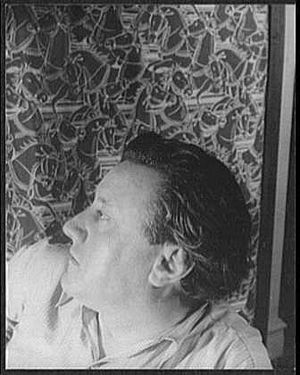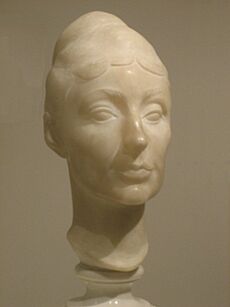Gaston Lachaise facts for kids
Quick facts for kids
Gaston Lachaise
|
|
|---|---|

Gaston Lachaise photographed by Carl Van Vechten, May 26, 1933
|
|
| Born | March 19, 1882 Paris, France
|
| Died | October 18, 1935 (aged 53) |
| Nationality | French |
| Education | École des Beaux-Arts |
| Known for | Sculpture |
|
Notable work
|
Standing Woman (1928-30) |
Gaston Lachaise (born March 19, 1882 – died October 18, 1935) was a talented sculptor. He was born in France but became famous in America in the early 1900s. Gaston learned the basics of sculpture in France. While he was still a student, he met and fell in love with an American woman named Isabel Dutaud Nagle. He followed her to America, where he was amazed by the energy and opportunities of his new home. These big life changes helped him find his unique artistic style. His drawings, often artworks on their own, also showed his fresh way of looking at the female body.
Contents
Early Life and Art Training
Gaston Lachaise was born in Paris, France. His mother, Marie Barré, was the daughter of a sculptor. His father, Jean Lachaise, was a cabinetmaker. Jean designed furniture for famous places, including Gustave Eiffel's apartment in the Eiffel Tower.
When Gaston was 13, he went to a craft school called the École Municipale Bernard Palissy. There, he learned about decorative arts. From 1898 to 1904, he studied sculpture at the École des Beaux-Arts. His teacher was Gabriel-Jules Thomas. Gaston started his art career working for the French Art Nouveau designer René Lalique.
Moving to America
Around 1902 or 1903, Gaston Lachaise met Isabel Dutaud Nagle. She was an American woman of French Canadian background. Gaston fell in love with her. Isabel later divorced her husband and married Lachaise.
In 1904, Isabel went back to her home near Boston. Lachaise promised to follow her. He worked for René Lalique again to earn money for his trip. In 1906, he arrived in America and never returned to France.
For the next 15 years, Lachaise worked as an assistant to other sculptors. First, in Boston and Quincy, Massachusetts, he helped H. H. Kitson. Kitson was an academic sculptor who mostly made military monuments. In 1912, Lachaise moved to New York City to help Kitson in his studio. Soon after, he began working for the sculptor Paul Manship. He also started creating his own art. He worked for Paul Manship until 1921. You can see later works by both sculptors at Rockefeller Center.
Lachaise had many studios in Greenwich Village, New York. He also bought a summer home and studio in Georgetown, Maine, in 1922. The artist Marsden Hartley often visited him there.
Famous Sculptures and Artworks
Lachaise developed his unique art style in the early 1900s, after meeting Isabel. But it was after he came to America that he fully understood his main idea: "Woman" as a powerful force, inspired by his beloved Isabel. He described his early sculptures of "Woman" as strong and solid, like the earth itself.
In 1917, Lachaise became an American citizen and married Isabel. His art career in New York quickly took off. His first solo art show was in 1918 at the Bourgeois Galleries. This show featured a large plaster model of his impressive work, Woman (Elevation) (made 1912–15, cast 1927).
Lachaise's most famous work is Standing Woman (made 1928–30, cast around 1933). This sculpture is perhaps the best example of his main artistic idea. Lachaise was also known for making portraits. He created busts (sculptures of heads and shoulders) of famous writers and artists. These included Marianne Moore, Georgia O'Keeffe, John Marin, and Lincoln Kirstein.
In 1935, the Museum of Modern Art in New York City held a special exhibition of Lachaise's work. It was the first time this museum had a show for a living American sculptor.
Gaston Lachaise was a very skilled artist. He was good at many different art forms and techniques. He made both artistic and commercial pieces. His sculptures were usually made of bronze. However, he also loved carving stone. His work was chosen for several big building projects in New York, like at 195 Broadway and Rockefeller Center. He also made fountains and decorative bronze animals, which helped him financially. Still, Lachaise is best known for his ideal sculptures of "Woman."
By 1930, Lachaise was one of America's most successful sculptors. He had wealthy supporters who bought his art. However, he spent most of his money. He died unexpectedly from a serious illness on October 18, 1935. This was at the peak of his fame. He had even had to leave his New York studio a few weeks before because he couldn't pay the rent.
His later works changed how human bodies looked in extreme ways. They were very emotional and modern for their time. Many of these artworks were not seen by the public until decades after his death. They have helped people understand his artistic achievements even better.
ARTnews magazine called Gaston Lachaise the "greatest American sculptor of his time." He played a key role in the start of American Modernism. He did this with his new and exciting ways of showing the human body.
Art Collections
You can find Gaston Lachaise's artworks in many public collections around the world:
United States:
- Amon Carter Museum of American Art
- Art Institute of Chicago
- Addison Gallery of American Art
- Brooklyn Museum of Art
- Cleveland Museum of Art
- Currier Museum of Art
- Detroit Institute of Arts
- Fine Arts Museums of San Francisco
- Harvard University Art Museums
- Honolulu Museum of Art
- Indiana University Art Museum
- Memorial Art Gallery
- Metropolitan Museum of Art
- Minneapolis Institute of Art
- Milwaukee Art Museum
- Museum of Fine Arts, Boston
- Museum of Modern Art
- Nasher Sculpture Center
- National Portrait Gallery
- New Mexico Museum of Art
- Pennsylvania Academy of the Fine Arts
- Phillips Collection
- Sheldon Museum of Art
- Smart Museum of Art
- Smithsonian American Art Museum
- Virginia Museum of Fine Arts
- Walker Art Center
- Worcester Art Museum
Australia:
- The Australian National Gallery, Canberra, Australia
- The National Gallery of Victoria (NGV), Melbourne, Australia
Czech Republic:
- National Gallery Prague, Veletržní Palace, Czech Republic
France:
- Musée Courbet, Ornans, France
- Musée d'Art Modern de Paris, France
- Musée d'Art et d'Industrie de Roubaix, André Diligent, "La Piscine," France
United Kingdom:
- The Tate Modern, London, UK
Lachaise Foundation
In 1963, Isabel, Lachaise's widow, created the Lachaise Foundation. Its goal is to keep Gaston Lachaise's art available for everyone to enjoy.
Since the foundation started, several art galleries have represented Lachaise's artworks. These include Weyhe Gallery, Felix Landau Gallery, Robert Schoelkopf Gallery, Salander-O'Reilly Galleries, Gerald Peters Gallery, David Findlay Jr. Gallery, and Findlay Galleries.
Since 2003, art historian Virginia Budny has been writing a complete list of all Lachaise's artworks. This project is supported by the Lachaise Foundation.
See also
 In Spanish: Gaston Lachaise para niños
In Spanish: Gaston Lachaise para niños


